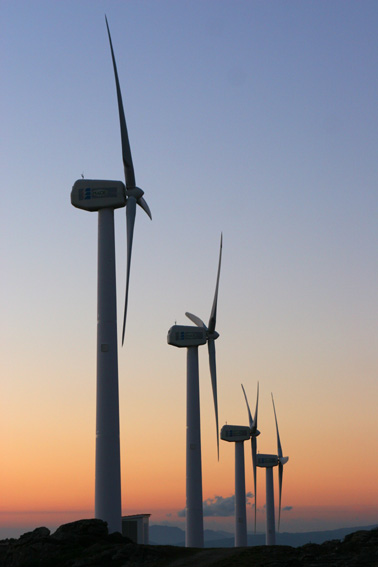Approximately 2% of the energy that comes from the sun is transformed into kinetic energy from atmospheric winds. 35% of this energy dissipates in the atmospheric layer only a kilometre above the ground. Of the rest, it is estimated that due to its random nature and dispersion only one thirteenth could be used, enough to supply the current worldwide consumption of primary energy 10 times over. Hence its enormous potential and interest.
For small-scale installations integrated in urban or semi-urban environments, there are both horizontal axis and vertical axis wind turbines. Today, for relatively small unit powers (from 20 kW or 30 kW) the most commercially available wind turbine technology is the horizontal axis: Each wind turbine basically consists of a windward rotor, usually equipped with three aerodynamically designed blades, which captures the energy of the wind and transforms it into mechanical rotational energy. The rotational movement is transmitted through an axis and several multiplying stages to a generator (generally synchronous or doubly fed asynchronous) whose function is to produce electrical energy. The elements described above are located on a gondola or frame supported, in turn, by a tower or shaft.
Wind farms, either on land or at sea, are formed by a series of wind turbines that capture the kinetic energy of the wind for its transformation into electrical energy. The electrical energy produced by each of the wind turbines, normally at medium voltage, is transported underground to a transformer station that raises its voltage and then, by means of an evacuation line, it is fed into the distribution or transport network at the authorised connection point.
Wind turbines are usually arranged in rows, perpendicular to the prevailing wind direction, separated by three rotor diameters. This separation aims to avoid the wind turbulence caused by each machine affecting the rest of the wind turbines. For the same reason, the separation between parallel rows of wind turbines is usually greater than seven rotor diameters.
Huge machines, with dimensions that defy the limits of the resistance of materials and the known techniques for transport and assembly, already exist in the market or are close to their commercial release: Rotor diameters up to 180 m, hub heights of 150 m and nominal unit powers of 10,000 kW. They are located on land, on the coast or offshore.
The applications for wind power are very diverse, depending on the size and location of the installations: They are used to generate electricity on a large scale, to supply electricity to homes or services which are isolated from the network, to pump water, for telecommunications systems, to desalinate seawater, etc.



